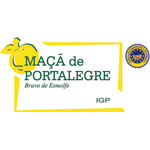Description
The Maçã de Portalegre PGI is an apple of the Malus Spp tree, in the Bravo de Esmolfe variety, resulting from the Camoesa and Melapio hybrid.
Production Area
Maçã de Portalegre PGI apples are grown in the municipal areas of Marvão, Castelo de Vide and Portalegre, in the Portalegre district.
Production Method
The Bravo de Esmolfe apple tree normally only produces fruit every two years but in the Portalegre region, in proof of the fertile conditions in this area, the trees regularly bear fruit every year. The trees are pruned during the winter months and the harvest, which is strictly manual, begins at the end of September.
Appearance and Flavour
The Maçã de Portalegre PGI apple is round and squashed at the ends, it has a greeny yellow colour and occasionally has red patches. It is strongly perfumed and sweet tasting. It is of medium size, between 60 mm and 70 mm.
History
The existence of the Bravo variety of apple in this area dates back to the beginning of the century. The introduction of this fruit represents one of the many successful attempts to grow these apples in an area other than where they originated, in the Beira region. The success achieved with the Maçã de Portalegre PGI apple is related to the proximity of the Serra de S. Mamede which has an influence on the properties of the Bravo apple of Portalegre to such an extent that it varies in both colour and size to that grown in the Beira area.
Gastronomy
Maçã de Portalegre PGI apples may be stored for several months if kept at a temperature of 2°C-4°C. They can be eaten as a table fruit or used as an ingredient for puddings and cakes and they are also used for making fruit juice.
Marketing
These apples are sold as Maçã de Portalegre PGI in three different categories depending on size: I, II and Extra. They are sold in wood or cardboard boxes containing only two layers of fruit and kept separate by special packing, in weights of a maximum of 15 kg.
Distinctive Features
Maçã de Portalegre PGI apples are harvested directly from the tree entirely manually and only the ripe fruit are picked. They are gathered in specially lined baskets to prevent bruising.







